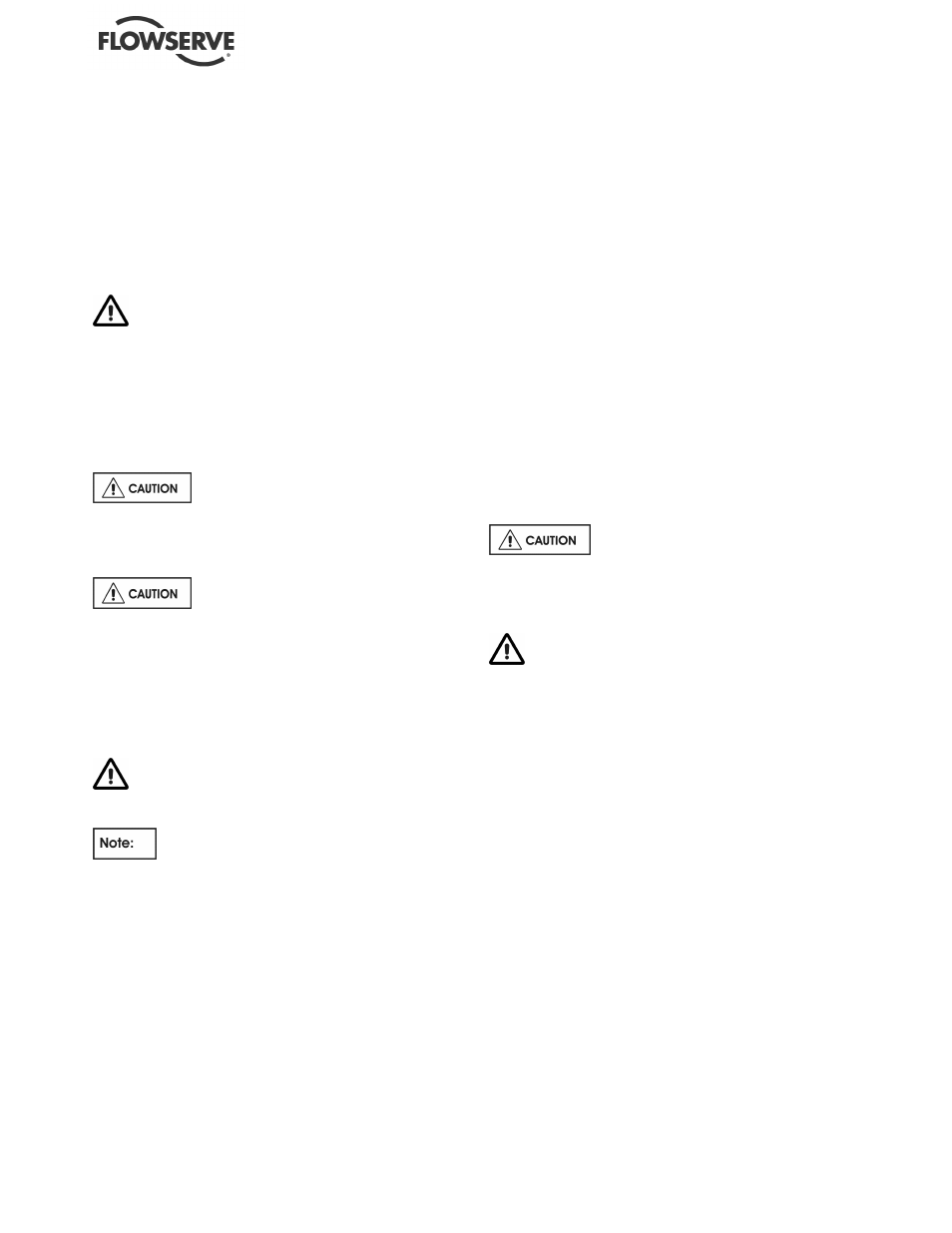Flowserve ESP3 User Manual
Page 34

ESP3 USER INSTRUCTIONS ENGLISH 26999943 08-11
Page 34 of 64
5.3 Impeller clearance
The impeller clearance was set at the factory. For
reverse-vane and recessed impellers, the clearance
is set to the cover while the open impeller clearance
is set to the casing
The impeller setting may be checked or change due
to wear. See Section 6.6.
5.4 Direction of rotation
5.4.1 Rotation check
It is absolutely essential that the rotation of the
motor be checked before installing the coupling drive
element. Incorrect rotation of the pump, for even a
short time, can dislodge and damage the impeller,
casing, shaft and shaft seal. All ESP3 3 pumps turn
clockwise as viewed from the motor end (top). A
direction arrow is cast on the support head [3160].
5.4.2
Coupling installation
Turn off the driver power and lock it
out so that the driver cannot be started during the
coupling assembly. Non-spacer couplings are used.
Mount coupling hubs/sheaves on pump and motor
shafts prior to attaching motor to the support head.
The coupling should be installed as
advised by the coupling manufacturer. Pumps are
shipped without the sleeve installed. If the sleeve
has been installed then it must be removed prior to
checking rotation. Remove all protective material
from the coupling and shaft before installing the
coupling.
5.5 Guarding
Power must never be applied to the driver when
the coupling guard is not installed.
In member countries of the EU and EFTA, it
is a legal requirement that fasteners for guards must
remain captive in the guard to comply with the
Machinery Directive 2006/42/EC. When releasing
such guards, the fasteners must be unscrewed in an
appropriate way to ensure that the fasteners remain
captive.
Flowserve coupling guards are safety devices intended
to protect workers from inherent dangers of the rotating
pump shaft, motor shaft and coupling. It is intended to
prevent entry of hands, fingers or other body parts into a
point of hazard by reaching through, over, under or
around the guard. No standard coupling guard provides
complete protection from a disintegrating coupling.
Flowserve cannot guarantee their guards will
completely contain an exploding coupling.
5.6 Priming and auxiliary supplies
A pump is said to be “primed” when the casing is
submerged and completely filled with liquid. Open
discharge valves a slight amount. This will allow any
entrapped air to escape and will normally allow the
pump to prime, if the liquid level is above the pump
casing. When a condition exists where the suction
pressure may drop below the pump’s capability, it is
advisable to add a low-pressure control device to shut
the pump down when the pressure drops below a
predetermined minimum.
Depending upon the bearing lubrication and shaft
seal option, some auxiliary supply lines may need to
be brought to the pump. Check to see if any other
connections need to be made to pump, such as fluid
injection to stuffing box for seal or packing lubrication
(when furnished) and make the required connections.
Check to see that connections are made to the
lubrication fittings at pump manifold [3869] on
mounting plate [6130]
Seals must never be run without
lubrication. Abrasive lubrication will greatly reduce
seal life.
5.7 Starting the pump
To avoid pump damage or injury to operating
personnel during start-up and operation:
•
DO NOT operate the pump outside of design
parameters.
•
DO NOT run with a closed discharge for more than
one minute.
•
DO NOT operate with safety devices (i.e. coupling
guard) removed.
•
DO NOT run the pump dry.
a) Ensure the pump is primed. (See section 5.6.)
The sump liquid level must cover the casing and
adapter. Minimum submergence number can be
found in Figure 3-6.
b) All flush lines must be started and regulated.
c) Start the driver (typically, the electric motor).
d) Slowly open the discharge valve until the desired
flow is reached, keeping in mind the minimum
continuous flow listed in Figure 3-2.
e)
Check all joints and mechanical seal (if
furnished) for leakage.
f)
If packing is furnished, adjust the packing gland
and flush flow.
g)
Check for excessive vibration.
h)
Monitor bearing temperature until it stabilizes.
